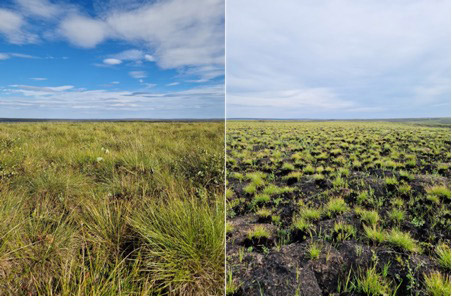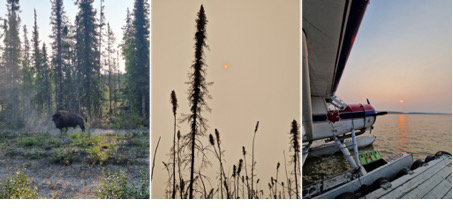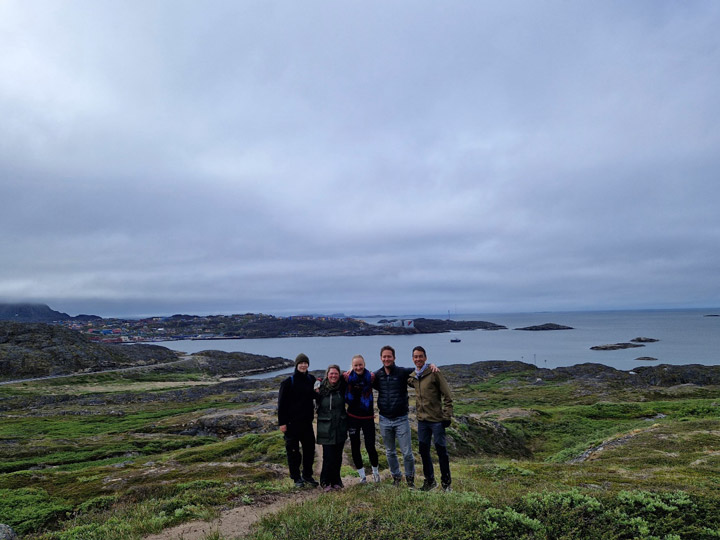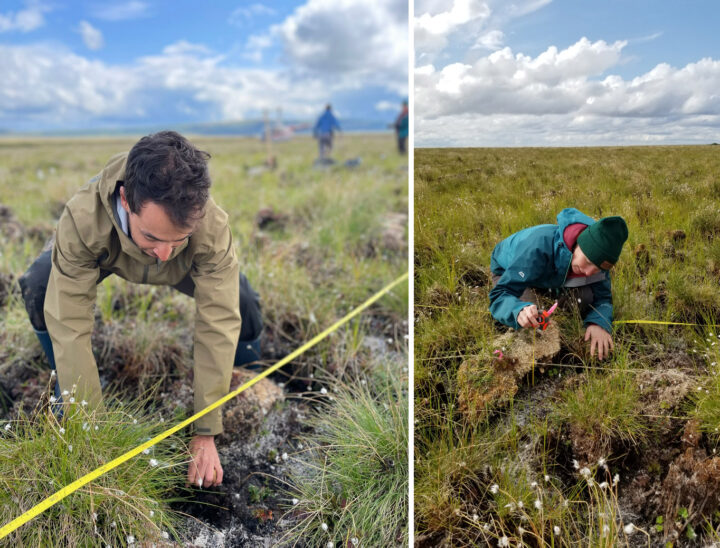

After our adventures in Quebec and Greenland, it was now time for our last stop in this intense season of fieldwork. This time we were heading to the Canadian Northwest Territories (NWT). Extraordinary wildfire seasons have become a regular occurrence in the NWT. The territory’s 10-year average for the total number of fires was exceeded in 2022, with nearly 600,000 hectares burned in 256 fires. At the time, that was more than any year since the outlier season of 2014. This may seem like a lot, but 2023 was brutal and far more exceptional.
The 2023 record fire season totaled around 3.6 million hectares burned by 303 fires. About 70 percent of the territory’s population, including the capital Yellowknife, was evacuated in the summer of 2023. The current Canadian fire season is also shaping up to be one of the most extreme in the last two decades. These extreme fire seasons have a significant impact on carbon emissions into the atmosphere. In response, our goal for this campaign was to obtain critical field observations to better estimate these emissions, so we packed our bags one last time for this summer and traveled as far north as Inuvik to begin our final data collections.

Despite the significant advances in understanding carbon emissions from boreal forest fires in recent years, there are still substantial gaps in our knowledge when it comes to high-latitude tundra fires. Field-based carbon combustion measurements from tundra fires are scarce, and although these fires have historically been less frequent than those in boreal forests, they can be substantial due to the availability of carbon-rich organic soils in these regions. Part of our team on this expedition has previous field experience with tundra fires, and we know that tussocks can be used as reference points to estimate how much of the soil organic layer was lost due to fire.

In 2023, a large tundra fire broke out near the town of Inuvik. North of the Arctic Circle, the fire is in a fairly remote area with no road or river access. So, we sampled this fire by helicopter in an effort to estimate and date carbon stocks and calculate the amount of carbon released into the atmosphere. Along the fire perimeter, we found different types of dominant vegetation in the tundra, ranging from the tussocks to shrublands and even sparsely treed areas.
The view of the northern landscape was mesmerizing from above! The rolling hills stretched endlessly across the horizon, while the striking polygonal soil patterns and distinctive pingos added to the captivating view. The tundra was dotted with lakes of various sizes and ancient riverbeds. With paleo specialists Atte Korhola and Jan Weckström accompanying us, we couldn’t resist the opportunity to sample a lake and study the historical fire record preserved in its sediments. We are grateful to the Aurora Research Institute and the local community for welcoming us.

After an intense week in Inuvik, our team hit the road again, this time heading south to the Scotty Creek Research Station, about 50 kilometers from Fort Simpson. We began our journey from Yellowknife to Fort Simpson, uncertain whether the ongoing fires would allow us to travel. The smell of smoke was overwhelming, and the sight of the recently burned forest along the road was stark. Along the gravel road to Fort Simpson, we encountered bison, sampled some peatlands, and spent an hour waiting for a ferry. In the evening, we watched as the moon took on an intense red hue, tinted by the smoke particles in the air.
The next morning, we boarded a floatplane from the Mackenzie River to the Scotty Creek Research Station, where a friendly crew gave us a warm welcome. The research station is so isolated that it’s only accessible by plane. The creek, where the station is located, drains a 152-square-kilometer area of boreal forested peatland. Due to the permafrost in the region, significant thawing has transformed parts of the landscape from forested permafrost to treeless wetlands. In October 2022, the station suffered massive damage from an extraordinary late-season wildfire that raged for nearly 100 days before finally reaching the camp. The research station had just reopened during our stay there. This is good news for the entire scientific community, given the importance of this unique site in the heart of the boreal forest.

The goal of our Scotty Creek campaign was to sample the effects of fires on peatland ecosystems, aiming to better understand the climate change implications of wildfire in this fire-sensitive landscape. We spent three days in the field, sampling key ecosystems from sunrise until sunset.
A special shoutout goes to the station crew, whose professionalism made everything run smoothly. After long days of work, returning to camp was a treat, especially with our hosts preparing dinner for us. We’ll never forget their hospitality—thank you, Scotty Creek team!

And so, our journey comes to an end. It was a summer to remember, one filled with hard work but also moments of joy and discovery. People will read this post, and in the near future, others will study the findings of our field research. Our results may be cited and applied by fellow scientists. Yet, no data or paper can truly capture what this season of fieldwork was like. Only we hold those memories. The months of preparation that preceded the trip: developing research protocols, selecting sites, navigating logistics, and endless paperwork. The long hours driving both paved and dirt roads. Fieldwork under the scorching sun, and other days when cold rain chilled us to the bone. The relentless mosquitoes. Simple lunches in the field contrasted with the risotto made from mushrooms foraged at burned sites. The flat tire. The cracked car window. Lost pens. Inventorying more than 400 trees in a single plot. Charcoal covering our hands and faces day after day. Setting up camp in incredible, remote places. The joy of plunging into a cold lake after a hard day of work. Spontaneously stopping the car on our day off because the excitement of sampling two more sites was too hard to resist. Unexpectedly gaining four extra days in Greenland due to a canceled flight. Swimming in the frigid waters of a fjord. Climbing to the summit of a mountain.
We have had the privilege of visiting places most people will never see, and for that, we are deeply grateful. This chapter of fieldwork for our Ph.D. research is over, but the Arctic continues to warm, and intense fire seasons in these regions are here to stay. We are eager to better understand the complex interactions between these changes and Arctic-boreal fires. As we return home, our suitcases packed with data, the time for analyses begins—now from our offices, but with this field season always on our minds.

The NWT fires expedition was organized within the Research Council of Finland Academy Research Fellow project “Fire in the Arctic,” led by Meri Ruppel, and the Kone Foundation project FLARE. The fieldwork was also part of FireIce (Fire in the land of ice: climatic drivers & feedbacks), a Consolidator project led by Sander Veraverbeke and funded by the European Research Council. FireIce is affiliated with NASA’s Arctic-Boreal Vulnerability Experiment (ABoVE).
This blog post was co-written by Lucas R. Diaz, a Ph.D. student at Vrije Universiteit Amsterdam, and Sonja Granqvist, a Ph.D. student at the University of Helsinki, both studying Arctic-boreal fires.

A combined team from the University of Helsinki (Environmental Change Research Unit), the Finnish Meteorological Institute (Atmospheric Composition Unit), and the Vrije Universiteit Amsterdam (Climate & Ecosystems Change) was on its way again to gather groundbreaking data on carbon and aerosol emissions from increasing fires in the northern high latitudes. Our journey began in boreal Quebec and now continues to Arctic Greenland.

Climate change is warming the Arctic with partly unexpected consequences. In recent years, unprecedented wildfires have raged through Arctic permafrost terrain burning in 2019 and 2020 alone, an area equal to half of what burned in the previous 40 years. In Greenland, a land known for its icy expanse, fires are rare. However, in July and August 2019, the second-largest wildfire recorded on the island occurred at the Kangerluarsuk Tulleq, northeast of Sisimiut. To our knowledge, fire effects in Greenland have never been studied—until now, as we begin our investigation.

To estimate the carbon burned and greenhouse gases and aerosols released during tundra fires, we assess post-fire ecosystem effects. We measure the dominant ecosystem types within the fire scar and compare them with unburned areas. We evaluate fire severity, and we conduct various aboveground and belowground measurements to calculate and date carbon stores.
Our campaign aimed to efficiently use 29 hours at the destination by collecting samples from all major ecosystems within the fire scar. We arrived by boat (hiking from Sisimiut is also possible but would take 2 days) and spent the day sampling. We camped near the shore, with some of us taking a daring dip in the sea. We continued sampling the next day before returning to Sisimiut in the evening. The study area exemplified the Arctic steppe ecoregion, featuring fragmented ecosystems ranging from barren rocky slopes and drier fields dominated by moss and lichen to moderately wet peatlands. We successfully collected a diverse set of samples from various ecosystems for detailed lab experiments and analysis to be performed back in Finland.

As we were preparing to head home from Greenland, we encountered unexpected foggy weather, which led to flight cancellations for several days. This gave us a well-appreciated few extra days of adventure. Three of us packed our hiking gear and embarked on an overnight hike. The summit of the two mountains we climbed was unforgettable. A key lesson for traveling in Greenland: keep your schedule flexible—it’s worth it!
Overall, the field campaign was a unique, once-in-a-lifetime experience. But that’s not all—can you guess where the fiery journey of Granqvist and Diaz will take them next? Stay tuned!

The Greenland fire expedition was organized within the Research Council of Finland Academy Research Fellow project “Fire in the Arctic,” led by Meri Ruppel, and the Kone Foundation project FLARE. The fieldwork was also part of FireIce (Fire in the land of ice: climatic drivers & feedbacks), a Consolidator project funded by the European Research Council. FireIce is affiliated with NASA’s Arctic-Boreal Vulnerability Experiment (ABoVE). This blog post was written by Sonja Granqvist, a Ph.D. student at the University of Helsinki, studying Arctic-boreal fires in collaboration with the Climate & Ecosystems Change research group from the Vrije Universiteit Amsterdam.
This blog post is the first in a series to come. Our team, the Climate & Ecosystems Change research group from the Vrije Universiteit Amsterdam, is working in collaboration with the Environmental Change Research Unit from the University of Helsinki for a summer with lots of fire field work, science, and adventure. On this journey, our first stop was the Quebec province in Canada. I’m writing this post after our last day of fieldwork here.
The 2023 wildfire season was the largest on record in Canada, with more than double the burned area as the second largest year. In Quebec, an estimated 4.5 million hectares were burned, an area slightly larger than the size of the Netherlands. This record-breaking fire season in Quebec was due to extreme warm and dry conditions. The dense smoke plumes from the 2023 Quebec blazes shocked the world when the smoke reached several cities on the US East Coast, including New York City.
Fellow scientists have been digging deep to understand and explain the phenomena involved in this Quebec fire season. However, as far as we know, estimates of carbon combustion, or the amount of carbon per area burned that is released during a fire, have never been made in Quebec. That’s why we are on it! In loco, since field measurements are a prime way to quantify carbon emissions from fires.

We assess post-fire ecosystem effects to calculate carbon pools below and above ground. In other words, this is the carbon stored in the soil and vegetation. After collecting soil samples and inventorying the vegetation, we can compare burned and unburned (control) locations to estimate how much of this carbon was emitted to the atmosphere due to fire. We do this comparison based on what is called the adventitious root method. On black spruce trees, adventitious roots grow above the initial root collar into the upper soil layers and provide a reference for the pre-fire soil height, as they remain clearly visible many years after fire.

During our expedition, we covered more than 4,000 kilometers on the road. We started by traveling north from Montreal along the James Bay Road and began our sampling at two fires near the locality of Radisson, where the remote Trans-Taiga road was our daily route. We then headed to Waskaganish, on the southeast shore of James Bay, where we sampled another fire. Finally, we ended our campaign at a large fire in the commercial forest near the town of Lebel-sur-Quévillon. All these trips allowed us to make a scientifically interesting transect from North to South in the Quebec province. We also got to know some incredible places, and we are grateful to the people living there who welcomed us.
We were able to observe two different types of intermixed ecosystems in the fires we visited. We found forests dominated by black spruce in peaty lowlands. In drier and often rocky uplands, Jack pine trees dominated. I’m curious to see how these differences will be reflected in practice when we analyze the carbon combustion in these systems.

Our team in the campaign was Lucas Diaz, Max van Gerrevink, Thomas Janssen, Yuquan Qu, and Sander Veraverbeke from VU Amsterdam, and Sonja Granqvist from the University of Helsinki. The success of this expedition is also thanks to our collaborators here in Quebec who helped us during our preparation: Dominique Arseneault (Université du Québec à Rimouski), Jonathan Boucher and Yan Boulanger (Canadian Forest Service), and Fabio Gennaretti (Université du Québec en Abitibi-Témiscamingue).
This fieldwork is part of my PhD project, so I was responsible for leading and organizing the entire expedition. As hard as it was, the whole process was also a lot of fun. Several times during the campaign, I felt like I was on a holiday road trip with a group of friends. In the end, that’s not entirely wrong. This kind of experience brings us closer to people. It strengthens existing bonds and creates new ones. This great adventure gave me moments that I will remember forever.
Time passes quickly here in the boreal forest. Soon, it will be time to pack our bags and embark on the next stage of this fiery journey. Curious about the destination? Stay tuned!

The Quebec fires expedition is part of FireIce (Fire in the land of ice: climatic drivers & feedbacks). FireIce is a Consolidator project funded by the European Research Council. FireIce is affiliated with NASA’s Arctic-Boreal Vulnerability Experiment (ABoVE). This blog post was written by Lucas Ribeiro Diaz, a Ph.D. student at Vrije Universiteit Amsterdam, studying Arctic-boreal fires by combining field and remote sensing approaches.
I’m writing this post on our last day in St. Mary’s, Alaska. This tiny village of about 560 inhabitants had its surroundings ravaged by two large tundra fires in the summer of 2022. The East Fork fire was the second largest tundra fire in Alaska in over 40 years and the biggest in Southwest Alaska. These events were historic, and I could start this post by writing about the intense and productive three weeks of work we had here. However, this whole project started much earlier.
I started this Ph.D. with plans to do field work in Siberia. However, halfway through, due to the pandemic and geopolitical issues, I saw all those plans slip through my fingers. Despite being from a country with among the greatest biodiversity in the world (Brazil), the arctic-boreal environments have always fascinated me. So in the winter of last year, when I came across these fires while analyzing satellite images, I knew this was a unique opportunity to pack my bags and finally be in the tundra. I remember showing the first satellite images and data of these fires to my supervisor, Dr. Sander Veraverbeke, and he confirmed that these fires were indeed scientifically very interesting and logistically feasible for our expedition. From then on, a long process of preparation began.

As this field campaign is part of my Ph.D. project, I was responsible for planning both the scientific and logistical aspects. Now, reflecting after the final day of sampling, it is incredibly rewarding to see that the planning has paid off. We sampled 11 days by boat along the Andreafsky River sampling the East Fork fire and another five days by helicopter sampling the Apoon Pass fire. Our main goal was to estimate the carbon combustion from these fires, that is, the area-normalized emissions in grams of carbon per square meter. Field measurements are the prime way to accurately quantify carbon combustion. To do it, we collected soil samples and estimated the burn depth of the soil organic layer. It is crucial to advance the quantification of tundra fire carbon combustion and understanding its environmental drivers.

In addition to carbon emissions, another key point of our expedition is to understand the effects of fires on permafrost. Previous research has shown that fires in the boreal forest increase the thaw depth of the active layer above permafrost, which can lead to permafrost degradation. We are curious to investigate this mechanism in the tundra, even more so now that we have found ice-rich permafrost during our fieldwork.

But it was not just the work that was amazing during this campaign. The tundra landscape was always breathtaking. Both from above with the helicopter and along the river from the boat. We were presented with a stunning rainbow on our first day using the helicopter. Wildlife was always around: moose, bears, beavers, eagles, geese, and countless other bird species.


Lucas Ribeiro Diaz, Max van Gerrevink, Rebecca Scholten, Sonam Wangchuk, Thomas Janssen, Thomas Hessilt, and Sander Veraverbeke were part of this field expedition. Our team is part of the Climate & Ecosystems Change research group at the Vrije Universiteit Amsterdam. However, the success of this campaign would not have been possible without the help of our boat driver, David ‘Matty’ Beans, and our helicopter pilot, Savanna Paulsen. We are also grateful to the city of St. Mary’s and its people for warmly welcoming us during these weeks. Finally, Dr. Lisa Saperstein from the U.S. Fish and Wildlife Service in Alaska has provided tremendous help when we were organizing our campaign.

45 plots, 1,383 tussocks measured, 255 soil samples, 495 thaw depth measurements—numbers like these make us believe that we have just concluded a field campaign on some of the most densely sampled tundra fires in the history of science. Now, we have three more weeks of work ahead of us at the USGS soil laboratory in Anchorage. With lots of ideas in my head, I’m excited to see the new findings this valuable data can reveal!
I have just finished writing this post and I realize that perhaps it is too personal. But it could not be otherwise. Our science often blends in with who we are, our dreams and expectations. I leave St. Mary’s feeling fulfilled, I think I have always dreamed of being here. I leave the tundra sure that moments like this are the reason I decided to embark on this journey of doing research.
This tundra fires field expedition is part of FireIce (Fire in the land of ice: climatic drivers & feedbacks). FireIce is a Consolidator project funded by the European Research Council. FireIce is affiliated with NASA ABoVE. This blog post was written by Lucas Ribeiro Diaz, a Ph.D. student at Vrije Universiteit Amsterdam, studying arctic-boreal fires by combining field and remote sensing approaches.
Just like the undulating terrain of the tussocky tundra we traverse, our days also take unexpected twists and turns. After a beautiful last day of sampling the East Fork fire scar along the Andreafsky River, where three moose visited us and delivered a personal goodbye, we were all excited for our first day of sampling the Apoon Pass fire scar via helicopter. But our spirits were momentarily dampened by news of Savanna, our pilot flying in from Nome, getting stuck in a thunderstorm on her way to our base in St. Mary’s, Alaska. Her arrival, delayed until early afternoon, was just the prelude to a challenge-laden morning.
Further issues emerged with our satellite communications device, requiring transatlantic collaboration with our colleagues in Amsterdam (many thanks to Thomas for his unwavering support!) These obstacles left us momentarily uncertain about the feasibility of flying at all that day. Miraculously, by 2 p.m., the looming cumulus of problems and bad weather began to disperse, and by 2:30 p.m., with a renewed sense of purpose, we embarked on our mission to sample the second fire of our field campaign.

The flight itself proved to be a standout experience, treating us to a breathtaking panorama over the hilly tundra that we had sampled along the Andreafsky River in the preceding days. The Apoon Pass fire scar, though not far from the East Fork fire, is geographically quite different, as it is located in very flat lowland terrain. Flying over the last crests of the hill range provided a captivating sight of the vast lowlands extending in all directions.

To our surprise, we were only able to spot the difference between burned and unburned tundra when descending to a relatively low altitude. This observation, together with the satellite imagery prepared by our campaign lead Lucas, led us to an initial conjecture that fire severity would be lower than what we had previously seen.
To systematically assess fire severity and carbon emissions in our plots, we are following protocols established by Mack et al. (2011) and Moubarak et al. (2023) for tundra fires in Alaska. We use two independent methods to estimate the burn depth based on the height of tussocks and Sphagnum (peat moss) patches in our plots. For the tussock-based method, we compare the height of tussocks that survived the fire with the height of tussocks in unburned locations. This gives us an estimate how much duff and other organic material has been combusted. For the Sphagnum-based method, we connect different moss patches of similar height with a thread and measure the distance from the thread to the surface at 25-centimeter intervals. This will give us an overview of the variability in burn depth within our sampling locations.
These two measurements will allow us to quantify the amount of carbon combusted per plot, which we can relate to the satellite imagery, as well as to the thickness of the active layer we are measuring at each plot to assess how the fire is affecting the permafrost.

In the end, to our surprise, our first helicopter day turned into one of the best sampling days we had during the campaign so far. We were gifted with beautiful, sunny weather until 9 p.m., and sampled even more plots than we had initially expected. We have now become a well-oiled machine, capable of sampling a plot within a mere hour and a half. Having the helicopter with us at all times offered an invaluable advantage—the ability to swiftly transport parts of our team to nearby sampling sites. After having returned to our base, we are excited for another day in the beautiful tussock tundra of southwestern Alaska—keeping our fingers crossed for another couple of days of good weather!
